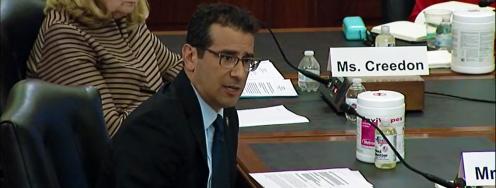Drafting to Begin for Iran Nuclear Deal
On the radar: Nuclear deal in the forecast; Fear of sanctions hampers good faith transactions; the Crimea crisis and nuclear zero; Pentagon plans to plan nuclear force cuts; NNSA finds budget numbers that make it look good; DOE to subsidize the unaffordable; Moscow forgets about Lisbon Agreement; and North Korea makes Asian pivot deployments possible.
April 7, 2014 | Edited by Lauren Mladenka and Geoff Wilson
Deal to come - “World powers and Iran will start drafting a final nuclear agreement next month, a U.S. official said Friday in a surprisingly optimistic assessment that expressed hope that a comprehensive pact could be reached in July,” reports Bradley Klapper for AP. According to a U.S. official, “the goal remains to seal a final pact before July 20, without the need for a six-month extension. The official said much of the work remaining was technical in nature, but noted that nothing had yet been agreed.” Full story here. http://abcn.ws/1e54gZ8
Tweet - @michaeldrich: #Iran, the region, and the U.S. after a nuclear deal. Report on last week's @RANDCorporation conference. #IranTalks http://bit.ly/1hKlCtE
Locked up funds - “Iran has been unable to withdraw much of the unfrozen oil revenue it was to receive under a November interim nuclear deal, a possible complication for efforts to end the decade long standoff over Tehran's nuclear ambitions,” the Wall Street Journal reports. “One reason Iran is having difficulty tapping the unfrozen revenue is that banks remain fearful they could violate tight U.S. financial sanctions, especially while the outcome of talks on a final nuclear deal remains uncertain. If financial institutions flout sanctions, they could be shut out of the U.S. banking system, which clears dollar transactions, or face huge fines.” Read the full article here. http://on.wsj.com/1hTynCh
Zero, after Crimea - Five years after President Obama’s ambitious Prague speech, “the idea of seeking to eliminate all nuclear weapons has nearly evaporated from international politics,” writes George Perkovich in The National Interest. “Vladimir Putin’s invasion of Ukraine in flames memories of the Soviet invasion of Prague in 1968. Russia’s bullying leaders cling to nuclear weapons as badges of great power and bulwarks against Western and Chinese coercion. In Asia, China and Japan mobilize air and naval forces to contest disputed islands in the East China Sea, prompting the U.S. to buttress capabilities and resolve to defend Japan while warning both sides not to precipitate a crisis.”
--“In this environment it is tempting to dismiss the goal of nuclear abolition as a fleeting dream of a new president and international do-gooders. However, turning away from fundamental questions about the future role of nuclear weapons cedes too much importance to transient political trends and neglects issues of great strategic import. The happenings of the past five years should not be allowed to foreclose serious analysis and debate looking to the future.”
--“The fact that major-power relations are far from such cooperation today means that the objective of nuclear abolition will not be achieved soon. This might comfort those who fear nuclear disarmament, but it is cold comfort indeed. For, the world would be more secure if the three most influential nuclear powers were actively seeking to create the conditions that would allow them and others to do without the singular threat of nuclear war. This was the aspiration Barack Obama announced in Prague five years ago. Whether history will remember it as tragic, farcical, or prophetic, will depend most immediately on the actions of the United States, Russia, Ukraine, the European Union, China and Japan in the coming years.” Read the full article here. http://bit.ly/1fWSA9x
Finally - “Pentagon leaders expect to soon give President Obama a plan for specific U.S. nuclear cuts to bring the arsenal in line with arms control caps,” writes Sebastian Sprenger in Global Security Newswire. “It's a vexing challenge to look at all of the factors involved and the relative advantages of decreasing [intercontinental ballistic missile] silos and decreasing [submarine-launched ballistic missile] tubes on submarines," says Adm. James Winnefeld, the vice chairman of the Joint Chiefs of Staff.
--“At issue is how the Pentagon will alter its mix of delivery vehicles for nuclear weapons -- ground-launched Minuteman 3 missiles, submarine-launched Trident D-5 missiles, and bombers -- to meet limits of the New START agreement with Russia. Beyond the 700-system cap, 100 delivery platforms are allowed in reserve,” Sprenger says. Read the full piece here. http://bit.ly/1ip9iNe
Numbers game - “Nuclear-arms officials said a Los Alamos National Laboratory security update was done under budget, despite millions of dollars in unplanned costs,” Diane Barnes reports for Global Security Newswire. “The U.S. National Nuclear Security Administration on Thursday said it spent $1 million less to improve protections at a sensitive area of the New Mexico site than its ‘original budget’ had allocated.
--“However, the picture is a bit more complicated than that; program costs went down in April 2011, only to skyrocket anew later on as security boosts were installed at aging Los Alamos lab facilities that handle plutonium usable in nuclear arms. Fixing the issues ultimately required tens of millions of dollars in unplanned expenses and more than a year of additional work… The nuclear agency could still say that the project wrapped up ‘under budget,’ though, because its earliest cost estimate was far greater than a projection it adopted later on… The cost of fixing the system's problems apparently eliminated most of the earlier-anticipated savings. Still, the project came in just short of the initial $245 million estimate, according to an NNSA news release.” Get the full story here. http://bit.ly/1hTG8bw
MOX subsidy - “If the United States decides to finish building the South Carolina plant converting weapons-grade plutonium into fuel for nuclear reactors, the federal government will subsidize the sale of the fuel to American utility companies,” reports Mary Orndorff for the Greenville Times. One administration official suggested that, to create demand for MOX fuel, the government would have to heavily subsidize MOX until it’s priced in line with uranium fuel.
--“To sell the MOX fuel to utilities at the cost of uranium fuel is totally crazy because MOX will cost many times more to fabricate...They would be basically giving it away,” said Tom Clements. Read the full story here. http://grnol.co/1h7SUTL
Cold shoulder - “Russia is unfazed by the U.S. announcement last week that anti-missile cooperation talks have been suspended due to the events in Ukraine,” Global Security Newswire reports. “The two countries had been holding preliminary discussions on areas of possible missile defense collaboration in accord with a 2010 Lisbon agreement. However, the talks never gained much traction due to fundamental differences of opinion about U.S. missile interceptors planned for fielding in the coming years in Europe. Moscow sees the weapons as a threat to its nuclear arsenal and does not accept political assurances from Washington that the missiles are only intended as protection from possible attacks launched from the Middle East.” Full story here. http://bit.ly/1lFIXxk
Ballistic missile destroyers to Japan - “The U.S. will deploy two additional ballistic missile defense destroyers to Japan by 2017 as part of an effort to bolster protection from North Korean missile threats, Defense Secretary Chuck Hagel said Sunday.”
--“The announcement of the deployments of additional destroyers to Japan came as tensions with North Korea spiked again, with Pyongyang continuing to threaten additional missile and nuclear tests. North and South Korea fired hundreds of artillery shells into each other's waters in late March in the most recent flare-up… The two additional ships would bring the total to seven U.S. ballistic missile defense warships in Japan, and it continues U.S. efforts to increase its focus on the Asia Pacific.” Read the full story from Lolita C. Baldor for the AP. http://abcn.ws/1oGJoMA
Quick-hits:
--“What the Air Force Can Learn from the Nuclear Cheating Scandal” by
--“Iran Upbeat on Nuclear Talks, Says All Sticky Issues Addressed” by Mehrdad Balali in Reuters. http://reut.rs/1ss52DK
--“Iran Hopes Drafting of Nuclear Deal Can Start Soon” by Parisa Hafezi and Fredrik Dahl in Reuters. http://reut.rs/PFuVRm
--“Examples of Differing Views of Nuke Missile Force” from AP. http://apne.ws/1ssapCQ
--“Better to dismay allies now than to infuriate them later” by Alexander Lanoszka for The Washington Post. http://wapo.st/1gDh9Vd
Events:
--“Fiscal Year 2015 Atomic Energy Defense and Nuclear Forces.” Hearing from the House Armed Services Subcommittee on Strategic Forces. April 8 from 3:30-5:30. Webcast available on the committee website. http://1.usa.gov/1mUx4na
--Fourth anniversary of the signing of the New START nuclear arms reduction treaty by President Obama and Russian President Dmitry Medvedev. Prague. The treaty reduces the maximum number of deployed strategic nuclear weapons by the United States and Russia from 2,200 to 1,550 each.
--“National Nuclear Security Administration management of its National Security Laboratories and the status of the Nuclear Security Enterprise.” Hearing from Senate Armed Services Subcommittee on Strategic Forces Subcommittee. April 9 at 2:30. Webcast available on the committee website. http://1.usa.gov/1qeqJVP
--“The Iranian Nuclear Talks and Regional Arms Control." Discussion with Sameh Aboul-Enein, Ziad Ali Khalil Abu Zayyad, Shlomo Brom, and Hillel Schenker. April 10 from 12:00-2:00 at the At Women’s National Democratic Club, 1526 New Hampshire Ave., NW, Washington. RSVP here. RSVP by email to fes.temp2@fesdc.org
--“Challenges to Further Nuclear Arms Reduction.” Discussion with Dennis Gromley, Götz Neuneck, and Nikolai Sokov. April 14 from 2:00-3:30 at Brookings Institution, Saul/Zilkha Rooms, 1775 Massachusetts Ave., NW, Washington. RSVP here. http://bit.ly/1jnQbFs
--“Making a Difference: Faith Communities Speak to the Humanitarian Impact of Nuclear Weapons.” Discussion with Andrew Kanter, Daryl Kimball, and eight other speakers. April 24 from 9:30-4:00 at the U.S. Institute of Peace, 2301 Constitution Ave., NW, Washington. http://conta.cc/1ssfg70



